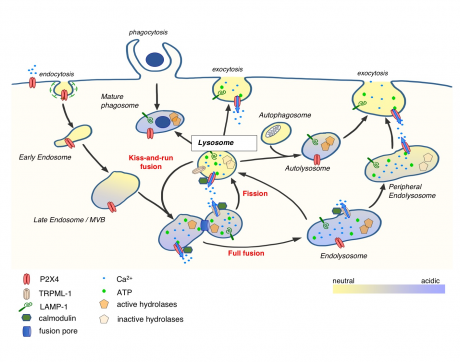ION CHANNELS: THEIR CELL BIOLOGY, FUNCTION AND REGULATION
We are interested in the structure and function of ion channels and understanding their regulation and misregulation in health and disease. Changes in ion channel signaling underlies many pathologies, hence they are important targets for development of novel therapeutics. We utilize a combination of molecular and cell biological techniques combined with functional analysis of channel properties to investigate ion channel regulation at the level of the assembly of the channel complex, trafficking and targeting of the complex within the cell, and the identification of protein and non-protein regulatory molecules.
Ion Channels and Pain
There is currently a large unmet need for new and safe therapies to treat chronic pain, as emphasized by the recent press coverage of the “opioid epidemic” in the US, where the use of opioid analgesics for treatment of pain have led to widespread addiction and drug abuse. We are part of Sussex Neuroscience (SN) and the Sussex Drug Discovery Centre (SDDC) and hence ideally placed to investigate potential new therapeutic targets for treatment of pathological pain.
Our current projects include a member of the family of voltage gated potassium channels (Kv9) for which there is genetic association with human pain linked to cancer, post-operative and sickle cell anaemia. This is a ‘silent’ subunit that associates with Kv2.1 to modulate the properties of the functional channel complex. These ion channels are important not only as regulators of the firing properties of sensory neurons but also for their non-conducting functions. These non-conducting functions include the regulation of secretion and the regulation of junctions that form between the plasma membrane and intracellullar compartments; sites of critical importance for cell signalling.
We are part of a team of scientists within the Sussex Drug Discovery Centre who are studying the properties of ion channels formed from Kv2 and Kv9 subunits. We use a range of cell/molecular biology and imaging techniques combined with functional assays including patch clamp electrophysiology. Our aims are two fold: 1) to elucidate the molecular mechanisms of action of these ion channels that underlies their association with pathological pain, and 2) to identify novel ligands that enhance the activity of these channels, with the potential to form novel therapeutics for treatment of chronic pain.
P2X Purinergic Receptors, Lysosomal Calcium Signalling and Cancer
The P2X family of membrane receptors are cation channels that open upon binding extracellular ATP and are widely distributed throughout all major systems in the body, playing a key role in in the generation of inflammatory responses, afferent signaling and the regulation of blood flow. High extracellular ATP occurs following tissue injury, at sites of inflammation and in cancers and it is known as a DAMP (Damage Associated Molecular Pattern) molecule. The effects of pathologically high levels of ATP are mediated primarily via the low affinity P2X7 receptor which is up regulated in many disease states. Another P2X receptor that is commonly co-expressed with P2X7 is P2X4. This has high affinity for ATP and is predominantly targeted to endolysosomal compartments where it plays a role in the regulation of lysosome fusion. Both receptors are linked to pain, inflammation and cancer.
Our work in this area is currently focused on three main objectives: 1) to understand the role of lysosomal P2X4 receptors in lysosome trafficking and signalling, 2) to understand the role of P2X4 in breast cancer, and 3) to identify mechanisms of regulation of P2X7 receptor signaling.
The Sigma1 receptor and its regulation of Calcium Signalling
The Sigma1 receptor is resident within the endoplasmic reticulum (ER) and acts as a chaperone protein and a regulator of ion channels, both within the ER and at the plasma membrane. It is widely distributed in the brain and in peripheral tissues and is also highly expressed in cancer cells. It been implicated in several diseases that include cancers, neurodegenerative disorders and pain but surprisingly its mechanisms of action are still unclear. It has a rich pharmacology, and binds a wide variety of ligands including neurosteroids, benzomorphans and psychotropic drugs that are currently in clinical use.
Our work in this area has been focused on elucidating the mechanisms by which Sigma1R controls intracellular calcium signaling, particularly focused on the dynamic interplay between ER, mitochondrial and cytosolic calcium signals. Sigma1 regulates calcium fluxes at junctions between ER and mitochondria and between ER and the plasma membrane. Our hypothesis is that this underlies its role in neurodegeneration and pain.

P2X4 and the trafficking and fusion of lysosomes
The ATP-gated cation channel, P2X4, is rapidly internalized from the plasma membrane and traffics to endolysosome membranes where it is orientated with its ATP-binding domain facing the lumen. Lysosomes actively accumulate ATP and are also important Ca2+ stores. The release of Ca2+ from lysosomes is the trigger for lysosomes to fuse with other compartments, including endosomes, phagosomes, autophagosomes and the plasma membrane. The activity of lysosomal P2X4 receptors is dependent upon luminal pH in addition to ATP, with receptors strongly inhibited at the acidic pH that is typically associated with lysosomes. The acidity of lysosomal compartments is however quite variable with terminal storage lysosomes having a neutral pH, whereas endolysosomes, formed by the fusion of late endosomes with lysosomes, have an acidic pH and are sites of active acid hydrolase activity. Trafficking of endolysosomes to the periphery is also associated with a decrease in their acidity. P2X4 receptor activity is enhanced by a decrease in acidity and this promotes lysosomal fusion. In contrast, TRPML-1 channels are oppositely regulated by pH and their activation promotes lysosome fission. Surprisingly both fusion and fission are dependent upon release of Ca2+ from lysosomes and the involvement of calmodulin, which binds to P2X4 amd TRPML-1.


